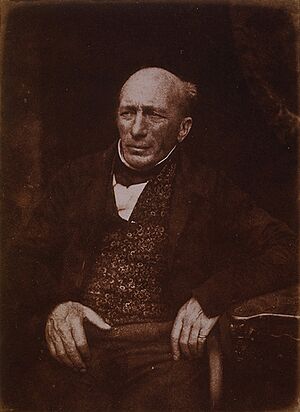Robert Barclay Allardice facts for kids

Robert Barclay Allardice (born 1779, died 1854) was a famous Scottish walker. People usually called him Captain Barclay. He was known as "the celebrated pedestrian" because of his amazing walking skills.
His most famous achievement was walking 1000 miles in 1000 hours. He did this in 1809 and won 1000 guineas (a type of old British coin). Many people see him as the founder of a sport called pedestrianism. This sport was an early version of racewalking.
Captain Barclay should not be confused with his father, who also took the name Robert Barclay Allardice. His father helped to rebuild the town of Stonehaven.
Contents
Captain Barclay's Family History
Robert Barclay Allardice came from a very old Scottish family, the Clan Barclay. He was the great-grandson of Robert Barclay (1648–1690). This earlier Robert Barclay wrote an important book defending the Quaker faith. The family who started Barclays Bank were also related to this Robert Barclay.
Captain Barclay's father was Robert Barclay, who was born in 1732. His father was a Member of Parliament for Kincardineshire. Captain Barclay's father later married Sarah Ann Allardice. She was related to old Scottish kings and nobles. Because of her important family, Captain Barclay's father decided to add "Allardice" to his name. Captain Barclay was born the year after his parents married.
Some members of the Barclay family were known for being very strong. The first owner of Ury House was said to be one of the strongest men in the country. Captain Barclay's own father was also a great walker. He once walked 510 miles from Ury to London in just 10 days!
Captain Barclay lived in a place called Fritwell Manor in Oxfordshire.
Amazing Walking Achievements
Captain Barclay completed many incredible walks. Here are some of his most famous feats:
- In 1801, he walked 110 miles (177 km) in a muddy park. It took him 19 hours and 27 minutes.
- In 1802, Barclay walked 64 miles (103 km) in just 10 hours.
- In 1805, he walked 72 miles (116 km) between breakfast and dinner.
- In 1806, Barclay walked 100 miles (161 km) on difficult roads. He finished in 19 hours.
- In 1807, he walked 78 miles (125 km) on hilly roads. This walk took him 14 hours.
The Famous 1000-Hour Walk
Captain Barclay's most famous challenge happened in 1809. It took place in Newmarket. He had to walk 1 mile every hour for 1000 hours in a row. This meant walking for 42 days straight! He made a bet to win 1000 guineas.
This challenge really captured the public's attention. Even The Times newspaper, which usually didn't report much general news, wrote about it. They printed a story about his walk next to news about a war!
The newspaper said that Captain Barclay finished his task easily. A huge crowd of people watched him complete his last mile. So many people came that they had to put ropes around the walking area. Captain Barclay seemed to get stronger towards the end. He even changed into a flannel jacket and thicker shoes. He planned to wake himself up a few times after the walk. This was to avoid his body getting too used to resting after so much exercise.
People were so sure he would succeed that no one would bet against him anymore. Many important people came to watch him finish. These included dukes, earls, and lords. It's believed that the total amount of money bet on his walk was around £100,000. In today's money, that would be like £5 million (or $US 8 million)!
During the 42 days, Captain Barclay's walking speed changed. At first, he walked a mile in about 15 minutes. By the end, it took him about 21 minutes. He also lost a lot of weight. He went from 186 pounds (84.5 kg) down to 154 pounds (70 kg).
Later, a woman named Emma Sharp successfully completed the same amazing feat.
Training Boxers
Besides walking, Captain Barclay also helped train bare-knuckle boxers. He supported them financially and taught them. Two of the most famous fighters he trained were Tom Molineaux and Tom Cribb, who was the Champion of England.
His Army Career
Captain Barclay was an officer in the 23rd Regiment of Foot. He joined the army in 1805. In 1809, just five days after finishing his 1000-mile walk, he went to war. He served as an aide to the Marquess of Huntly in a difficult military campaign called the Walcheren Campaign.
Claims to Old Family Titles
Captain Barclay tried to claim some old family titles, like the Earldom of Airth. His lawyers argued that this title could be passed down through the female side of the family. However, the House of Lords (a part of the British Parliament) rejected his claim in 1839. He also had a similar claim to other titles, but he did not pursue them. Interestingly, if he had won one of these claims, it would have meant he was the rightful King of Scotland!
What Happened After Captain Barclay Died
Captain Barclay died in 1854. He was injured by a horse's kick. He had one daughter who survived, named Margaret. She moved to America but later returned to Great Britain. Her eldest son, also named Robert Barclay-Allardice, became Mayor of Lostwithiel. His descendants live in Gloucestershire and Hampshire today.
The ownership of Ury House, which could only be passed down to male family members, went to a distant cousin.

